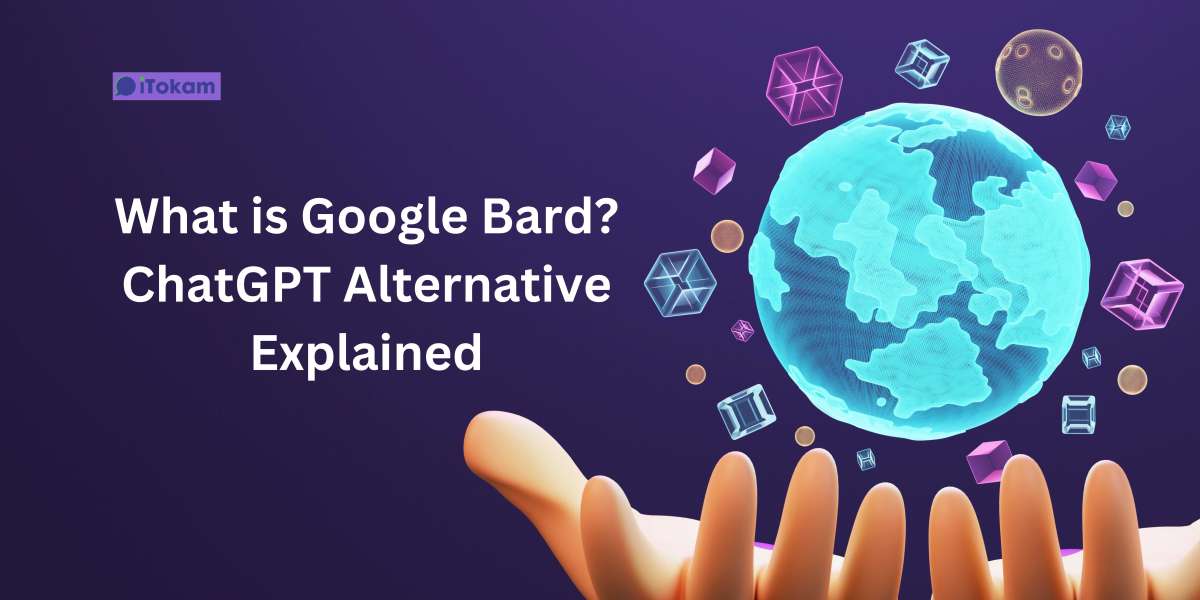When compared to other technologies, AI is light years ahead. Artificial intelligence (AI) aids individuals, organizations, and communities by realizing their full potential in areas such as disease detection and information access, regardless of language barriers. As a result, doors have opened that could vastly improve the quality of life for billions of people.
Google Bard; What is it?
Google Bard is a chatbot that mimics human speech using artificial intelligence techniques like machine learning and natural language processing. Bard can be implemented into websites, messaging platforms, or applications to deliver genuine, natural language responses to user questions, and it can also be used as a supplement to Google search.
Google developed the AI language model "LaMDA" (Language Model for Dialogue Applications), which serves as the foundation for Bard. Both ChatGPT and LaMDA are designed to generate human-like responses to text-based input, however, there are some key differences between the two.
How Does Google Bard Work?
Bard is a large language model, also known as a conversational AI or chatbot, as already established above, trained to be informative and comprehensive. It is trained on a massive amount of text data, which enables it to communicate and generate human-like text in response to a wide range of prompts and questions. For example, Bard can provide summaries of factual topics or create stories.
Google Bard works by first analyzing the prompt or question that you send to its chat box. It then uses the built-in AI's understanding of language and its knowledge of the world to produce a response that is pertinent, detailed, and all-encompassing. Although Bard is still developing, but it has been released for use and have learned to perform many kinds of tasks, including
The ability to follow your instructions and complete your requests thoughtfully.
Even if your questions are vague, difficult, or strange, it will still use its knowledge to provide you with a thorough and instructive response.
Additionally, Bard generate different creative text formats of text content, like poems, code, scripts, musical pieces, email, letters, etc. It will always try to fulfill all your requirements.
Besides the above, in a more technical narrative:
Bard is a deep neural network, which is a type of machine learning model that is trained on a massive amount of data.
The data that Bard is trained on is a massive dataset of text and code. This dataset includes books, articles, code, and other forms of text.
Bard uses this data to learn the patterns of human language.
When you give Bard a prompt or question, Bard uses its knowledge of language to generate a response that is relevant, informative, and comprehensive.
To start using Google Bard, you need to have a Google account. Visit the website and login with your Google account and start using Bard. Note that you can not use Bard if your Google accpount is managed by Family Link or Google Workspace.
In what year did Google Bard debut?
Google started encouraging users to join a queue for Bard on March 21, 2023. Google discontinued the backlog for Bard and released it in more than 180 countries and territories on May 10, 2023. However, on May 13, Bard became available for use to the public
But before the final release, on February 6, 2023, Google unveiled Bard with no specific release date. Many people thought Google rushed Bard to market because of the attention and praise surrounding ChatGPT. For instance, it answered a question incorrectly during a live demonstration by Sundar Pichai, the CEO of Google and Alphabet.
Who is Qualifies to use Google Bard?
Anyone who is at least 18 years old and has a Google Account can use Bard. You can use Bard in any supported web browser, including Chrome, Firefox, Safari, and Edge.
To use Bard, simply go to the Bard website and sign in with your Google account. Once you are signed in, you can start asking Bard questions or giving it prompts. Bard will try its best to answer your questions and complete your requests thoughtfully.
Are There Any Drawbacks to Using Bard?
The initial demo made it abundantly clear that Bard, like all AI chatbots, requires training and learning in order to respond appropriately even when given false or misleading information. Because there is always more to learn, training AI is a computationally intensive process that never ends.
As with any other artificial intelligence technology, Bard may not always provide the most accurate or impartial answers to your inquiries or generate writing.
Remember that despite Bard's extensive training on text materials, the amount of data at its disposal is still limited. This means it might not be able to respond to inquiries on subjects that are underrepresented in the data in which it was trained in.
It's a machine learning model; therefore, it can't think or act on its own. The training data is the only source from which it can generate text.
Is Bard Freely Available for Use?
Yes, Bard is free to use. You can access Bard through the Bard website or through the Google Search app. There is no subscription or fee required.
Bard is still under development, but it is a powerful tool that can be used for a variety of tasks, including:
- Answering questions
- Generating text
- Translating languages
- Writing different kinds of creative content
And more!
Google has not yet indicated whether or not it will implement a fee for using its services. Apart from its cloud computing operations, Google has never charged users for access to its services. Assuming Bard is added to Google's core search functionality. It is currently available to the public at no cost.
Difference Between Bard and ChatGPT:
Both Google Bard and ChatGPT are large language models, also known as conversational artificial intelligence or trained chatbots. They are both trained on massive amounts of text data and are capable of communicating and generating human-like text in response to a variety of prompts and inquiries.
Nonetheless, there are significant distinctions between the two AI tools.
* Bard is trained on a continuously updated dataset of text and code, whereas ChatGPT was trained on a dataset that was last updated in 2021. This indicates that Bard is more likely to be knowledgeable about current events and fashions. Bard is intended to be informative and exhaustive, whereas ChatGPT is intended to be creative and engaging. This indicates that Bard is more likely to generate text that is entertaining or thought-provoking, whereas ChatGPT is more likely to generate text that is accurate and factual. ChatGPT utilizes generative AI, which allows it to generate original content. For instance, users can request that it compose a thesis on the benefits of AI. Google Bard does the same thing, albeit for a slightly different purpose. Bard is designed to make search more intuitive and useful, and it does incorporate new information into its answers.
* Bard is still in development, whereas ChatGPT is an established product. This means that Bard may not always be able to correctly answer your queries or generate perfectly accurate or impartial text. However, Bard is continuously learning and enhancing itself, so it will likely become more accurate and trustworthy over time.
However, ChatGPT can also assist in refining inquiries. Microsoft reportedly signed a $10 billion agreement with OpenAI in January to license and integrate ChatGPT into its Bing search engine to provide more conversational search results comparable to Google Bard. This allows other search engines to license ChatGPT, whereas Bard is only intended to support Google. In the future, Google might change its emphasis from concentrating solely on itself regarding Bard deployment.
Also Read: Quillbot Alternatives: Best Related Alternatives
Bard and ChatGPT are both potent applications that can be utilized for a variety of purposes. Your optimal model will depend on your particular requirements and preferences. If you require an informative and current model, Bard is an excellent option. If you require a creative and engaging model, ChatGPT is an excellent option.
Google Bard Comparables Alternatives
ChatGPT did not emerge from thin air. Artificially intelligent chatbots have existed for some time, albeit in less flexible forms. Similar chatbot platforms are being developed by numerous startups, but none have received the attention that ChatGPT has. Below are some of the rivals Bard is set to confront as it debuted to the public recently:
Microsoft Bing
Similar to Google's Bard, Microsoft's search is powered by AI and offered through a partnership with OpenAI. It can recognize queries made in natural language and return results in that same language. When someone conducts a keyword search, they will get the normal Microsoft Bing search outcomes as well as the responses produced by GPT-4, along with the option to interact with the AI pertaining to the answer.
Hemingway Editor:
Hemingway Editor is a writing tool that focuses on improving the readability and clarity of the content. The tool analyzes the content for complex sentences, passive voice, and excessive use of adverbs. It also provides suggestions for improving the sentence structure, word choice, and tone. Combining machine learning capabilities and other inbuilt AI technology, Hemingway Editor is a powerful tool for the discerning mind.
The difference Hemingway Editor brings to the market is available as a desktop application and an online editor. The promoters offer a free version with basic features, while the premium version provides access to all the advanced features.
Copy AI:
Copy AI is an automated writing tool.
With its advanced technologies and pre-made templates, it can assist you in producing higher-quality content and more persuasive sales copy. Businesses who want to develop interesting and high-quality content that is optimized for search engines should take use of Copy AI.
Intriguing, right? You don't need any prior experience with writing or design (or even WordPress) to get started. Copy AI makes it possible for anyone to easily create visually appealing content; all you need is some inspiration and a solid content brief (or set of instructions for the AI).
As I type this essay, I have Copy AI outlining what I want readers to know about the alternatives to QuillBot and then writing the essential elements about each of the alternatives we'll talk about below.
Some of the information is incorrect (Quillbot was not founded in 2012, nor was it created by Brian Dean; similarly, Brian Dean did not create Moz).
Therefore, a solid content brief and editorial direction are required. Overall though, it's a great tool that helps me produce content much more quickly.
In addition, they offer a fantastic paraphrase generator.
When compared to Quillbot, I like Copy AI better as a secondary option. Additionally, the price is reasonable. As an added bonus, they offer a fully functional free plan.
The monthly fee is $0 for the Free plan. But you can go for the Pro plan at $36/mo to harness more features from this powerful paraphrasing tool. While there is a fully functional free version available for evaluation.
ChatSonic
As a "ChatGPT rival with superpowers," ChatSonic is an artificial intelligence (AI) chatbot that uses Google Search and an AI-based text generator called WriteSonic to allow users to discuss topics in real-time while producing text or images. Only the evaluation edition is free. A charge per month must be paid to access the premium feature.
Jasper AI
Jasper AI is an artificial intelligence (AI) chatbot content writing tool that focuses on generating brand-relevant materials and engaging in discussions with consumers. It permits writers and editors to include SEO keywords and intonation in their prompts.
YouChat
YouChat is the artificial intelligence chatbot of the German-based technology firm known as the YouCom search engine. Not only does YouChat provide answers to queries, but it additionally offers citations so that users can verify the accuracy of Youcom's replies.
NeevaAI
NeevaAI, like YouChat, is a product of the German search engine corporation Neeva. It produces solutions using quotations from primary locations while offering links to cited sources. Additionally, it aggregates various sources in order to offer one response.
Conclusion:
The development of Bard represents a significant advancement in the field of natural language processing and demonstrates the growing capabilities of AI systems to mimic human creativity. However, there are also concerns about the potential impact of such technologies on the creative industries and the role of human artists and writers in society. While such concerns exit, it is a fantastic innovation for copywriters and other professionals in that space standout.




